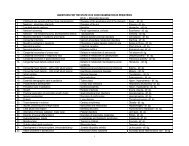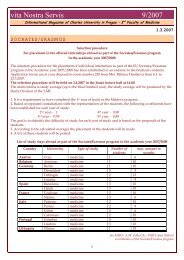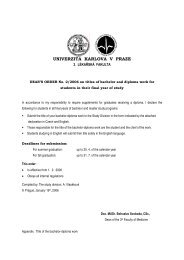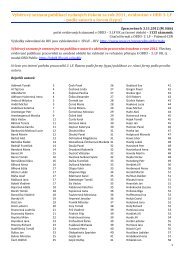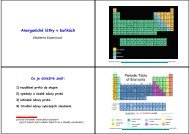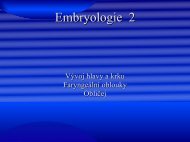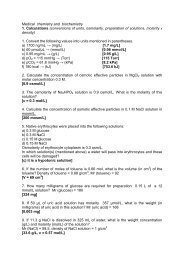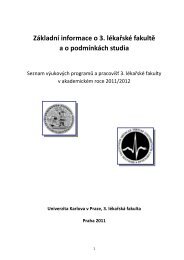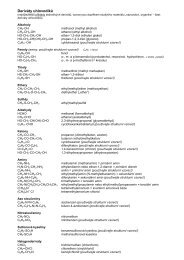Measurement of radioactivity. Radioactive decay is a random ...
Measurement of radioactivity. Radioactive decay is a random ...
Measurement of radioactivity. Radioactive decay is a random ...
You also want an ePaper? Increase the reach of your titles
YUMPU automatically turns print PDFs into web optimized ePapers that Google loves.
<strong>Measurement</strong> <strong>of</strong> <strong>radioactivity</strong>.<strong>Radioactive</strong> <strong>decay</strong> <strong>is</strong> a <strong>random</strong> process and therefore fluctuations are expected in the <strong>radioactivity</strong> measurement.That <strong>is</strong> why measurement <strong>of</strong> <strong>radioactivity</strong> must be treated by stat<strong>is</strong>tical methods.In every measurement a deviation from the true value or error <strong>is</strong> likely to occur. There are two types <strong>of</strong> errors ‐systematic and <strong>random</strong>. The accuracy <strong>of</strong> a measurement indicates how closely it agrees with the true value. Theprec<strong>is</strong>ion <strong>of</strong> a series <strong>of</strong> measurements describes the reproducibility and indicates the deviation from the averageor mean value. The closer the measurement <strong>is</strong> to the average value, the higher the prec<strong>is</strong>ion, whereas the closerthe measurement <strong>is</strong> to the true value, the more accurate <strong>is</strong> the measurement. It <strong>is</strong> important to keep in mind,that a series <strong>of</strong> measurements may be quite prec<strong>is</strong>e but their value may be far from the true value. Prec<strong>is</strong>ion canbe improved by eliminating the <strong>random</strong> errors, better accuracy <strong>is</strong> obtained by removing both the <strong>random</strong> andsystematic errors.The average or mean value <strong>is</strong> obtained by adding the values <strong>of</strong> all measurements divided by the number <strong>of</strong>measurements. The standard deviation indicates the deviation from the mean value and <strong>is</strong> a measure <strong>of</strong>prec<strong>is</strong>ion. The standard deviation in radioactive measurements indicates the stat<strong>is</strong>tical fluctuations in radioactived<strong>is</strong>integration. If the number <strong>of</strong> measurements <strong>is</strong> large, the d<strong>is</strong>tribution can be approximated by a Gaussiand<strong>is</strong>tribution even if the radioactive <strong>decay</strong> follows the Po<strong>is</strong>son d<strong>is</strong>tribution law. For practical reasons, only singlemeasurement <strong>is</strong> obtained on radioactive sample instead <strong>of</strong> multiple repeat counts to determine the mean value.The prec<strong>is</strong>ion <strong>of</strong> a count <strong>of</strong> a radioactive sample can be increased by accumulating a large number <strong>of</strong> counts in asingle measurement because <strong>of</strong> decreasing the standard deviation.Interaction <strong>of</strong> radiation with matter.All radiations may interact with the atoms <strong>of</strong> the matter during their passage through it producing ionization andexcitation <strong>of</strong> the atoms. These radiations are called ionizing radiation. The mechan<strong>is</strong>m <strong>of</strong> interaction differ forparticulate and electromagnetic type <strong>of</strong> radiation.The interaction <strong>of</strong> beta particles as a charged particles and gamma radiation as an electromagnetic radiation <strong>is</strong>the most important from the point <strong>of</strong> view <strong>of</strong> using them in nuclear medicine.Beta particles interact primarily with the electrons <strong>of</strong> the absorber atoms and rarely with the nucleus.Ionization occurs when beta particle transfers sufficient amount <strong>of</strong> its energy to the orbital electron and ejects itfrom the atom. As a result ion pair <strong>is</strong> formed. Th<strong>is</strong> process may rupture chemical bonds in the molecules.Ionization <strong>is</strong> used namely in the radiation therapy and also serves as a mean <strong>of</strong> the detection <strong>of</strong> charged particlesin ion chambers.When energetic beta particles, namely electrons, pass close to the nucleus <strong>of</strong> the atom, they lose energy as aresult <strong>of</strong> deceleration. Th<strong>is</strong> loss <strong>of</strong> energy appears as an x ray and <strong>is</strong> called bremsstrahlung. Bremsstrahlungproduction increases with the kinetic energy <strong>of</strong> the beta particles and the atomic number <strong>of</strong> the absorber. That <strong>is</strong>why high energy beta particles are stored in plastic rather than shielding by lead.Beta plus particles, positrons, combine with the orbital electrons and produce two 511 keV photons <strong>of</strong> gammaradiation, so called annihilation radiation, that are emitted in exactly opposite directions. Th<strong>is</strong> <strong>is</strong> the bas<strong>is</strong> <strong>of</strong>positron em<strong>is</strong>sion tomography.Gamma rays interact with orbital electrons and if their energy <strong>is</strong> very high they may also interact with the nucleus<strong>of</strong> the absorber atoms. They travel a long path in the absorber before losing all energy and so they are calledpenetrating radiations.There are three mechan<strong>is</strong>ms by which gamma rays interact with absorber atoms from which two are importantfor nuclear medicine.Photoelectric effect means transfer <strong>of</strong> all energy <strong>of</strong> gamma photon to an orbital electron, called photoelectron,and ejecting it from the atom. The photoelectron then loses its energy by ionization and excitation.
Compton scattering means transfer <strong>of</strong> only a part <strong>of</strong> energy <strong>of</strong> gamma photon to an electron and ejecting it. Thegamma photon with less energy <strong>is</strong> deflected from its original direction. The scattered photon may then underg<strong>of</strong>urther photoelectric or Compton interaction and the Compton electron may cause ionization or excitation.Depending on the photon energy and the density and thickness <strong>of</strong> the absorber, some photons may pass throughthe absorber without any interaction.Attenuation <strong>of</strong> gamma radiations by means <strong>of</strong> their interaction with absorber <strong>is</strong> an important factor in radiationprotection. The term half‐value layer <strong>is</strong> defined as the thickness <strong>of</strong> the absorber that reduces the intensity <strong>of</strong> aphoton beam by one half. It depends on the energy <strong>of</strong> the radiation and the atomic number <strong>of</strong> the absorber.Radiation detection.Interaction <strong>of</strong> ionizing radiations with the matter <strong>is</strong> also used for their detection and measurement. There areseveral principles <strong>of</strong> radiation detection in nuclear medicine. Some <strong>of</strong> them are used in radiation protection,others in measurement and imaging.The oldest principle <strong>is</strong> darkening <strong>of</strong> photographic emulsion. Th<strong>is</strong> principle <strong>is</strong> used in the personnel dosimetry. Thefilm badge <strong>is</strong> most popular and cost‐effective for personnel monitoring and gives reasonably accurate readings <strong>of</strong>exposures from beta, gamma and x radiations. The film badge cons<strong>is</strong>ts <strong>of</strong> a radiation sensitive film held in aplastic holder. Filters <strong>of</strong> copper and lead are attached to the holder to differentiate exposure from different typesand energies <strong>of</strong> radiation.Another principle <strong>is</strong> thermolumin<strong>is</strong>cence. Several inorganic crystals (e.g. LiF) can accumulate radiation energy andhold it. If the crystal <strong>is</strong> heated from 300 to 400 degrees <strong>of</strong> Celsius, it emits light in amount proportional to theabsorbed energy. Thermolumin<strong>is</strong>cent dosimeters, so called TLD, are mostly used as a finger dosimeters, soinorganic crystals are held in a plastic holders and plastic rings. It gives an accurate exposure reading and can bereused.Another principle <strong>is</strong> converting the energy <strong>of</strong> radiation to electric current. There are two basic principles based onionization and excitation.First <strong>is</strong> ionization <strong>of</strong> gas molecules, the second <strong>is</strong> excitation and ionization <strong>of</strong> solid, liquid or plastic material, calledscintilator, which emits photons <strong>of</strong> light after absorbing radiation. Light <strong>is</strong> then converted to the electric currentby means <strong>of</strong> photomultiplier tube.Gas‐filled detectors collect the ion pairs as a current with the application <strong>of</strong> a voltage between two electrodes.The measured current <strong>is</strong> proportional to the aplied voltage and the amount <strong>of</strong> radiation.At a lower voltages from 50 to 300 V, only the primary ion pairs formed by the initial radiation are collected.Ionization chambers operate in th<strong>is</strong> region. The detector <strong>is</strong> a cylindrical chamber with a central wire filled with airor different gases. These detectors are primarily used for measuring high intensity radiation. Dose calibrators andpocket dosimeters are the common ionization chambers used in nuclear medicine.The dose calibrator <strong>is</strong> one <strong>of</strong> the most essential instrument in nuclear medicine for measuring the activity <strong>of</strong>radionuclides and radiopharmaceuticals. It must be regularly checked for constancy, accuracy, linearity andgeometry.At higher voltages from 1000 to 1200 V, the current becomes identical regardless <strong>of</strong> how many ion pairs areproduced by the incident radiation. Geiger‐Müller counters operate in th<strong>is</strong> region. Geiger‐Müller counters areused to monitor the radiation level in different work areas and they are called area monitors or survey meters.They are more sensitive than ionization chambers but they cannot d<strong>is</strong>criminate between energies. They arealmost 100% efficient for counting alpha and beta particles but have only 1 to 2% efficiency for counting gammaand x rays.
Scintillation detectors cons<strong>is</strong>t <strong>of</strong> scintilator emitting flashes <strong>of</strong> light after absorbing gamma or x radiation. The lightphotons produced are then converted to an electrical pulse by means <strong>of</strong> a photomultiplier tube. The pulse <strong>is</strong>amplified by a linear amplifier, sorted by a pulse‐height analyzer and then reg<strong>is</strong>tred as a count. Different solid orliquid scintillators are used for different types <strong>of</strong> radiation. In nuclear medicine, sodium iodide solid crystals with atrace <strong>of</strong> thallium NaI(Tl) are used for gamma and x ray detection.The basic solid scintillation counter cons<strong>is</strong>ts <strong>of</strong> na NaI(Tl) crystal or detector, a photomultiplier (PM) tube , apreamplifier, a linear amplifier, a pulse‐height analyzer (PHA) and a recording device.NaI(Tl) crystals are hermetically sealed in aluminium containers. They are fragile and must be handled with care.Room temperature should not be changed suddenly because <strong>of</strong> possibility <strong>of</strong> cracks in the crystal. In well countersand thyriod probes smaller and thicker crystals are used, whereas larger and thinner crystals are employed inimaging devices like gamma cameras.PM tube cons<strong>is</strong>ts <strong>of</strong> a light‐sensitive photocathode facing the crystal, series <strong>of</strong> dynodes in the middle and ananode at the other end ‐ all enclosed in a vacuum glass tube. A high voltage about 1000 V <strong>is</strong> applied between thephotocathode and the anode <strong>of</strong> the PM tube. The electron pulse reaching the anode <strong>is</strong> delivered to thepreamplifier. The amplitude <strong>of</strong> the pulse <strong>is</strong> proportional to the number <strong>of</strong> light photons received by thephotocathode and in turn to the energy <strong>of</strong> gamma ray photon absorbed in the crystal. The applied voltage mustbe very stable.A linear amplifier amplifies further the signal from the preamplifier and delivers it to the pulse height analyzer foranalys<strong>is</strong> <strong>of</strong> its amplitude.A pulse height analyzer <strong>is</strong> a device that selects for counting only those pulses falling within preselect voltageintervals and rejects all others. Desired pulses are ultimately delivered to the recording devices such as scalers,computers, films and so on.In the output <strong>of</strong> scintillation counter a d<strong>is</strong>tribution <strong>of</strong> pulse heights will be obtained depicting a spectrum <strong>of</strong>gamma ray energies. In an ideal situation each gamma ray would be seen as a line on the gamma ray spectrum. Inreality, the photopeak <strong>is</strong> broder, which <strong>is</strong> due to various stat<strong>is</strong>tical fluctuations in the process <strong>of</strong> forming thepulses.When gamma rays interact with the scintillation crystal by means <strong>of</strong> Compton scattering, the Compton electrons<strong>of</strong> variable energies result in a pulse height smaller than that <strong>of</strong> photopeak. Thus the gamma ray spectrum willshow a continuum <strong>of</strong> pulses corresponding to Compton electron energies between zero and photopeak, so calledCompton continuous spectrum. The relative hights <strong>of</strong> the photopeak and the Compton scattering depend on thephoton energy as well as the size <strong>of</strong> the crystal.There are several basic character<strong>is</strong>tics <strong>of</strong> counters important from the point <strong>of</strong> view <strong>of</strong> using them in nuclearmedicine procedures.Background <strong>of</strong> the detector means reg<strong>is</strong>tered count rate without presence <strong>of</strong> any measured specimen. It <strong>is</strong>caused namely by cosmic radiation, natural <strong>radioactivity</strong>, <strong>radioactivity</strong> <strong>of</strong> building material and <strong>of</strong> the material thedetecting system cons<strong>is</strong>ts <strong>of</strong>. It can be minimized by shielding detector in lead cover, by using special material forits construction or by means <strong>of</strong> pulse‐height analyzer to exclude inappropriate radiation energy from detection.The energy resolution simply means the width or the sharpness <strong>of</strong> the photopeak or the ability to d<strong>is</strong>criminatethe gamma ray photons <strong>of</strong> similar energies.The detection efficiency <strong>is</strong> given by the observed count rate divided by the d<strong>is</strong>integration rate <strong>of</strong> a radioactivesample. It depends on the type and energy <strong>of</strong> the detected radiation, size and thickness <strong>of</strong> the detector crystaland geometric efficiency <strong>of</strong> the measuring.The dead time <strong>is</strong> the time period during which the counter <strong>is</strong> insensitive for the radiation detection. Th<strong>is</strong> time
enclosed time needed to process a radiation event starting from interaction in the crystal all the way up t<strong>of</strong>orming and recording pulse. Dead time for Geiger‐Müller detectors <strong>is</strong> from 100 to 500 microseconds, for NaI(Tl)crystal from 0,5 to 5 microseconds. Dead time loss <strong>of</strong> counts <strong>is</strong> a serious problem at high count rates. Either countrates must be lowered or corrections must be made to the observed count rates.Scintillation detectors can be used as a part <strong>of</strong> both nonimaging and imaging devices. From the nonimagingdevices, scintillation well counters and thyroid probes are used.The gamma well counter cons<strong>is</strong>ts <strong>of</strong> a scintillation detector with a hole in the center, for a sample to be placedinside for increasing the geometric efficiency and hence the counting efficiency <strong>of</strong> the counter, and otherassociated electronics. Well counters are used namely for in vitro measurements <strong>of</strong> different samples. They areusually available with automatic sample changers and are mostly programmable with computers. Their majoradvantage <strong>is</strong> high detection efficiency which <strong>is</strong> from 50% to 70% for 140 keV gamma photons.The thyroid probe <strong>is</strong> a scintillation counter used for measuring radioacitivity above the thyroid gland to assess theuptake <strong>of</strong> 131I after its oral admin<strong>is</strong>tration. In contrast to well counter the thyroid probe must be equipped withcollimator, which limits the field <strong>of</strong> view. Th<strong>is</strong> <strong>is</strong> a cylindrical barrel made <strong>of</strong> lead and it covers all the detectorincluding PM tube. It prevents the gamma radiations from other organs to reach the detector.Radionuclide imaging devices.Radionuclide imaging <strong>is</strong> based on the ability to detect electromagnetic radiation emitted from an injectedradioactive tracer that has been taken up by the organ to be studied. The electromagnetic radiation used <strong>is</strong> in theform <strong>of</strong> gamma rays or x rays. The radiation absorbed by the detector <strong>is</strong> used to generate a digital image by thecomputer, which <strong>is</strong> then interpreted by the physician. Th<strong>is</strong> imaging device <strong>is</strong> called scintillation camera or gammacamera. It also employs sodium iodide scintillation detector and the associated electronics like nonimagingsystems do.The most frequently used scintillation camera <strong>is</strong> <strong>of</strong> Anger type (Hal O. Anger invented it in the 1960), it means ithas a large scintillation crystal which makes possible to detect radiation from the entire field <strong>of</strong> viewsimultaneously and therefore it <strong>is</strong> capable <strong>of</strong> recording dynamic as well as static images <strong>of</strong> the area <strong>of</strong> interest inthe patient. Many soph<strong>is</strong>ticated improvements have been made <strong>of</strong> the cameras over the years, but the basicprinciples <strong>of</strong> the operation are essentially the same.Like nonimaging probe also scintillation camera cons<strong>is</strong>ts <strong>of</strong> a collimator, a scintillation crystal, PM tubes, apreamplifier, an amplifier, a pulse‐height analyser and recording or d<strong>is</strong>play devices. In addition it must have an X,Ypositioning circuit to localize the point <strong>of</strong> interaction <strong>of</strong> gamma ray with the crystal. The operation <strong>of</strong> a camera <strong>is</strong>performed by a computer built in it and <strong>is</strong> very convenient for the staff. The detector head (collimator,scintillation crystal, PM tubes and amplifiers) <strong>is</strong> mounted on a stand called gantry, which moves the head to theappropriate position for patient imaging.Detectors have usually large (about 50 cm in diameter) circular or rectangular NaI(Tl) crystal with about 1 cmthickness. In front <strong>of</strong> the crystal, a collimator <strong>is</strong> attached to limit the field <strong>of</strong> view so that gamma radiations fromoutside the field <strong>of</strong> view cannot reach the crystal.Collimator <strong>is</strong> usually a plate <strong>of</strong> lead with many holes. Most frequently used are parallel‐hole colimators with holesparallel to each others and perpendicular to the detector face. They are <strong>of</strong> different types according to energy <strong>of</strong>radionuclides used for imaging and according to their spatial resolution. Thus we can d<strong>is</strong>tingu<strong>is</strong>h high resolution,high sensitivity and all purpose (with comprom<strong>is</strong>e parameters) types or low, medium and high energy types. Thespatial resolution <strong>of</strong> the parallel‐hole collimators decreases with the increasing d<strong>is</strong>tance <strong>of</strong> the object from thefront <strong>of</strong> the collimator but the sensitivity <strong>is</strong> the same. That <strong>is</strong> why every data collection must be performed withthe minimal space between collimator forhead and the patient body surface.The collimator <strong>of</strong> conical shape with one up to three holes on the top <strong>is</strong> called pinhole and <strong>is</strong> used for imaging <strong>of</strong>small and near to the surface lying organs, such as a thyroid gland, tight join or infant kidneys. It has very goodresolution but very poor sensitivity. Nowadays also collimators with special converging holes called fan‐beam aremade for small organs imaging, such as a brain. Also collimators with diverging holes can be used, namely in
cameras with small crystal to make possible imaging <strong>of</strong> large organs. Collimators designed for higher energy arethicker with thicker septa between holes to prevent penetration <strong>of</strong> photons through them.Gamma cameras have many photomultiplier tubes (up to 90) mounted to the back <strong>of</strong> the crystal with opticalgrease. They are used to be <strong>of</strong> hexagonal shape and the output from each <strong>is</strong> used to define the X and Y coordinate<strong>of</strong> the point <strong>of</strong> interaction <strong>of</strong> the gamma ray in the crystal by the use <strong>of</strong> an X,Y positioning circuit. The X and Ypulses are than projected on a cathode ray tube or oscilloscope to create image or can be stored in the computerin a square matrix for further processing. The larger the number <strong>of</strong> PM tubes, the better the spatial resolution onthe image.The use <strong>of</strong> digital computers in nuclear medicine has considerably increased and today all nuclear medicinestudies are being analyzed by the computers. Data from a gamma camera must be digitized by the analog‐todigitalconverter. The computer memory approximates the area <strong>of</strong> the detector as a square matrix from 32x32 upto 1024x1024 size. Each element <strong>of</strong> th<strong>is</strong> matrix <strong>is</strong> called pixel and corresponds to a specific X and Y location in thedetector. The number in each pixel corresponds to the number <strong>of</strong> pulses detected in th<strong>is</strong> specific location <strong>of</strong> thecrystal. In th<strong>is</strong> manner <strong>of</strong> storing data in computer memory, called frame mode (the most common mode innuclear medicine), we must preset the matrix size, the number <strong>of</strong> images (frames) in the study, and the time <strong>of</strong>collection <strong>of</strong> data per frame or total counts to be collected per frame.Computers are very important part <strong>of</strong> imaging devices, current cameras cannot operate without it, namely ECT <strong>is</strong>impossible without computers. The basic function <strong>of</strong> computers during image construction <strong>is</strong> to correct andmaintain cameras performance parameters, such as high voltage in the PM tubes and photopeak setting in pulseheightanalyzer.Another improvement <strong>of</strong> image quality <strong>is</strong> achieved by images smoothing and filtering, mathematical operationwith images, background subtraction, creation <strong>of</strong> parametric and tomographic images, regions <strong>of</strong> interest (ROI)creation, dynamic curves creation and their mathematical processing with computing quantitative data <strong>of</strong>physiological processes, by using <strong>of</strong> interpolation to reduce digital raster effect on matrix image, smoothingimages by means <strong>of</strong> temporal and spatial filters or by color coding according to number <strong>of</strong> counts in each pixel.Very important camera parameter, field <strong>of</strong> view uniformity, can be effectively improved by means <strong>of</strong> computers.Detector uniformity means a uniform response throughout the field <strong>of</strong> view. Even properly tuned and adjustedgamma cameras produce nonuniform images with count density variation <strong>of</strong> up to 10%. There are severalpossibilities <strong>of</strong> using computer for nonuniformity correction. These are: correction <strong>of</strong> number <strong>of</strong> counts in eachpixel <strong>of</strong> image matrix to an average value, setting <strong>of</strong> the own photopeak for each pixel in image matrix, differentgain <strong>of</strong> high voltage for each photomultiplier tube and spatial d<strong>is</strong>tortion correction.To ensure a high quality <strong>of</strong> images, quality control tests must be performed routinely on these devices. The mostcommon tests are the positioning <strong>of</strong> the photopeak, field <strong>of</strong> view uniformity and background check, which mustbe performed daily. The spatial resolution <strong>of</strong> the camera should be checked weekly.Th<strong>is</strong> type <strong>of</strong> Anger gamma camera provide two dimensional images and that <strong>is</strong> why it <strong>is</strong> also called planar camera.According to the type <strong>of</strong> metabolic processes and the type <strong>of</strong> data recording we can d<strong>is</strong>tingu<strong>is</strong>h two basal type <strong>of</strong>collecting data.During static acqu<strong>is</strong>ition <strong>of</strong>images we can evaluate d<strong>is</strong>tribution <strong>of</strong> radiopharmaceuticals in the organs, which doesnot change in time. To achieve good information density <strong>of</strong> images, we must preset proper acqu<strong>is</strong>ition timeaccording to reg<strong>is</strong>tered count rate or we must preset needed number <strong>of</strong> collected counts. Except acquiringimages with the same size and shape as detector has we can also acquire a so called whole body images. In th<strong>is</strong>type <strong>of</strong> data collection patient on the examining table passes under or over the detector and the image <strong>of</strong><strong>radioactivity</strong> d<strong>is</strong>tribution in the whole body can be obtained. The velocity <strong>of</strong> the patient movement <strong>is</strong> again doneby the reg<strong>is</strong>tered count rate to ensure good image information density. Since <strong>radioactivity</strong> d<strong>is</strong>tribution does notchange significantly, we can collect data for a longer time period and thus high resolution collimator should beused.The second type <strong>of</strong> collecting data, during which we can evaluate differently fast metabolic or functioning
processes in the body (blood flow), <strong>is</strong> called dynamic study. According to velocity <strong>of</strong> assessing processes we mustpreset number <strong>of</strong> images (frames) and duration <strong>of</strong> one image. Because d<strong>is</strong>tribution <strong>of</strong> radiopharmaceuticalschanges rapidly and duration <strong>of</strong> one frame acqu<strong>is</strong>ition <strong>is</strong> limited (up to split second), high sensitivity collimatorsshould be used to achieve sufficient image information density.A special kind <strong>of</strong> collecting data <strong>is</strong> gated or synchronized method. It <strong>is</strong> used for acquiring a periodical organactivity, such as heart mechanical function. In th<strong>is</strong> example ECG signal <strong>is</strong> used for synchonization and by th<strong>is</strong> wayto collect data with very high temporal resolution <strong>is</strong> possible. In principle, computer divides each R to R intervalinto several intervals, for example twenty. Each interval has its own number, in th<strong>is</strong> example from one to twenty,<strong>is</strong> presented as a frame in the computer memory and its duration <strong>is</strong> <strong>of</strong> tens mil<strong>is</strong>econds. After R interval detectionby computer, data are stored into the frame number one, after the time <strong>of</strong> one frame duration <strong>is</strong> over data arestored into frame number two and so forth till the further R wave <strong>is</strong> detected. From th<strong>is</strong> point all the process <strong>is</strong>repeated and by th<strong>is</strong> way several hundreds heart cycles are summed into one, so image information density <strong>is</strong>sufficient for further processing.On planar images, the third dimension <strong>of</strong> d<strong>is</strong>played objects <strong>is</strong> obscured by superimposition <strong>of</strong> data. Thereforetomographic devices have been developed. Primarily, so called longitudinal tomography was used, which d<strong>is</strong>playsharply only one slice parallel to the face <strong>of</strong> detector. The images was not <strong>of</strong> good quality and thus nowadays onlytransversal tomography <strong>is</strong> used. In th<strong>is</strong> technique multiple views are obtained at many agles around the long ax<strong>is</strong><strong>of</strong> the patient and images in the slices perpendicular to the detector face, transversal slices (each element <strong>of</strong> th<strong>is</strong>slice <strong>is</strong> in the form <strong>of</strong> cube in the computer memory and <strong>is</strong> called voxel), are constructed by the computer. Sincein nuclear medicine the source <strong>of</strong> <strong>radioactivity</strong> <strong>is</strong> in the patient body, and the gamma photons or x rays areemitted from it, we talk about em<strong>is</strong>sion computed tomography (ECT). Th<strong>is</strong> technique improves images qualityand by th<strong>is</strong> way physician interpretation by means <strong>of</strong> a better contrast between target organ and background,better topography <strong>of</strong> pathological sites and higher detection efficiency <strong>of</strong> pathological lesions, which <strong>is</strong> done bybetter spatial resolution predominantly.According to the type <strong>of</strong> radionuclide used we can d<strong>is</strong>tingu<strong>is</strong>h two types <strong>of</strong> ECT. Single photon em<strong>is</strong>sion computedtomography (SPECT), which uses gamma emitting radionuclides (most <strong>of</strong> today used) and positron em<strong>is</strong>siontomography (PET), which uses positron emitting radionuclides.The SPECT cameras have in principle the same detector as planar cameras have, but the gantry makes possible torotate the detector around the patient. The minimal angle <strong>of</strong> rotation <strong>is</strong> 180 degrees at small angle incremets. Thepath around the patient can be circular or eliptical and current cameras have the possibility <strong>of</strong> so‐called bodycontouring pathway to minimize the d<strong>is</strong>tance between detector forhead and patient body surface. The data arestored in the computer for further processing and image reconstruction in the form <strong>of</strong> slices in threeperpendicullar planes <strong>of</strong> transverse, coronal (frontal) and sagittal direction. There are different designs <strong>of</strong> SPECTcameras with one, two or three detectors. SPECT image <strong>is</strong> a type <strong>of</strong> static image, so sufficient image informationdensity must be achieved. That <strong>is</strong> why about 20 to 30 minutes <strong>of</strong> time <strong>is</strong> needed to collect sufficient data. Wemust preset angle <strong>of</strong> rotation, angular step and time for one frame acqu<strong>is</strong>ition according to count rate detected.There are several mathematical algorithms to reconstruct images from acquired data. The most frequently used <strong>is</strong>so called filtered back projection. Filters are mathematical functions, which increase image quality and suppressartefacts. Various types <strong>of</strong> filters are commercially available in the form <strong>of</strong> s<strong>of</strong>tware packages. Another methodsfor image reconstruction are Fourier transform or iterative methods.PET <strong>is</strong> based on the detection <strong>of</strong> coincidence <strong>of</strong> the two annihilation gamma photons that are emitted afterinteraction <strong>of</strong> positron with electron in the patient body. These two photons, which ar<strong>is</strong>e at the same time, havethe same energy <strong>of</strong> 511 keV and are emitted in the angle <strong>of</strong> 180 degrees, are detected by the two detectorsconnected in coincidence. Data collected around the body ax<strong>is</strong> are then used for image reconstruction.In current PET systems, many detectors (hundreds to thousands) are arranged in circular rings. The number <strong>of</strong>rings can be up to sixteen and are arranged in arrays. Each detector <strong>is</strong> connected to the opposite detector in thesame ring by a coincidence circuit. The field <strong>of</strong> view <strong>is</strong> defined by the width <strong>of</strong> the array <strong>of</strong> detectors. For th<strong>is</strong>device no collimator <strong>is</strong> needed. Data are collected in the computer in the frame mode. Image reconstruction <strong>is</strong>accompl<strong>is</strong>hed by the same method as in the SPECT does.



